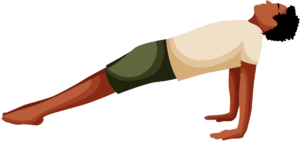Upward Plank (Purvottanasana)
Pose Overview
| Common Name | Upward Plank |
| Traditional Sanskrit Name | Purvottanasana |
| Sanskrit Name Pronunciation | pur-voh-tahn-AHS-uh-nuh |
| Pose Difficulty | Intermediate |
| Drishti
Drishti is the gaze or visual focus point during yoga poses.
Learn more about Drishti |
Upward, towards the sky |
Upward Plank Pose, also known as Purvottanasana, is a challenging, full-body strengthening pose that primarily works the core, arms, and shoulders. This pose is often used as a transition between other poses or as a preparatory pose for more advanced poses such as handstands and arm balances. The pose gets its name from the Sanskrit words "purva" meaning "east" or "previous" and "uttana" meaning "intense stretch." This refers to the fact that the pose stretches the body in the opposite direction from a traditional plank pose.
Benefits of Upward Plank
The Upward Plank Pose helps to strengthen the core, arms, and shoulders, improves balance and stability, and can help to improve posture. Additionally, this pose can also help to relieve stress and tension in the back and neck.
How to Enter Upward Plank
Start in a seated position with your legs extended in front of you. Place your hands behind your hips with your fingers pointing towards your feet. Press into your hands and lift your hips up towards the ceiling, straightening your arms. Engage your core and press your heels towards the floor, while keeping your gaze forward. Hold the pose for several breaths before exiting.
How to Exit Upward Plank
Slowly lower your hips back down to the floor. Release your hands and relax in a seated position.
Common Upward Plank Modifications & Variations
For a modified version of this pose, try lifting your hips only halfway up and holding on to your legs for support. To make the pose more challenging, try lifting one leg off the floor at a time for a one-legged variation.
Common Mistakes with Upward Plank
Allowing the lower back to sag or the shoulders to hunch forward. Placing the hands too far forward, which can put unnecessary strain on the wrists.
Safety Guidance
Those with wrist or shoulder injuries should avoid this pose or use modifications. Those with lower back pain should also use caution and avoid over-extending the lower back.

